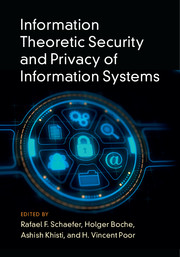Preface
Published online by Cambridge University Press: 28 June 2017
Summary
The ubiquity of information technologies such as wireless communications, biometric identification systems, online data repositories, and smart electricity grids has created new challenges in information security and privacy. Traditional approaches based on cryptography are often inadequate in such complex systems and fundamentally new techniques must be developed. Information theory provides fundamental limits that can guide the development of methods for addressing these challenges, and the purpose of this book is to introduce the reader to state-of-the-art developments in this field.
As a prototypical example of a system in which such methods can play an important role, one can consider a communication system. In a typical configuration, there is an architectural separation between data encryption and error correction in such systems. The encryption module is based on cryptographic principles and abstracts out the underlying communication channel as an ideal bit-pipe. The error correction module is typically implemented at the physical layer. It adds redundancy into the source message in order to combat channel impairments or multiuser interference and transforms the noisy communication channel into a reliable bit-pipe. While such a separation-based architecture has long been an obvious solution in most systems, a number of applications have emerged in recent years where encryption mechanisms must be aware of the noise structure in the underlying channel, and likewise the error correction and data compression methods must be aware of the associated secrecy constraints required by the application. Such joint approaches can be studied by developing new mathematical models of communication systems that impose both reliability constraints and secrecy constraints. Similar considerations arise throughout the information and communication technologies, and information theoretic approaches can point the way to fundamentally new solutions for such technologies. We refer to this emerging field of research as information theoretic approaches to security and privacy (ITASP). It is notable that this approach leads to guaranteeing information security irrespective of the computational power of the adversary and is a fundamental departure from current computation-based cryptographic solutions. In this book we will highlight among others the following application areas where principles of ITASP have been particularly effective.
- Type
- Chapter
- Information
- Information Theoretic Security and Privacy of Information Systems , pp. xix - xxiiPublisher: Cambridge University PressPrint publication year: 2017

